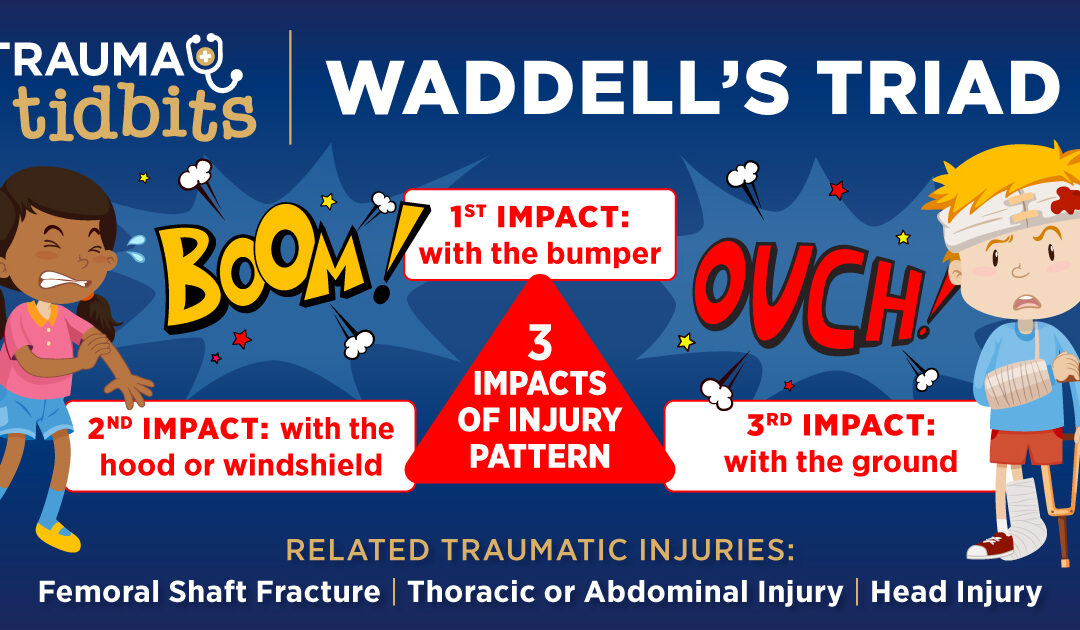Understanding specific injury patterns is critical for timely and accurate diagnosis and treatment in trauma care, particularly in pediatric patients. One such important injury pattern is Waddell’s Triad. Named after Dr. James Waddell, this Triad describes a set of injuries typically seen in children struck by a vehicle. Recognizing Waddell’s Triad can significantly influence the management and outcome of pediatric trauma patients.
What is Waddell’s Triad?
Waddell’s Triad consists of three primary injuries:
- Femoral Fracture: This is a break in the thigh bone, one of the most robust bones in the body. In a pedestrian-vehicle collision, this injury is usually caused by the vehicle’s direct impact on the child’s leg.
- Intra-abdominal or intrathoracic injury includes damage to internal organs such as the liver, spleen, or lungs. These injuries occur due to the blunt force of the collision and the secondary impact of the body against the ground or other objects.
- Head Injury: This can range from mild concussions to severe traumatic brain injuries (TBI). The head injury results from the child being thrown to the ground or hitting a hard surface post-impact.
Recognizing Waddell’s Triad
Early recognition of Waddell’s Triad is crucial for several reasons. First, children may not always be able to communicate the extent of their injuries due to shock, fear, or altered mental status from head trauma. Medical personnel need to have a high index of suspicion for these injuries based on the mechanism of injury alone.
- Clinical Assessment:
History and Mechanism: It is essential to understand how the injury occurred. Ask witnesses or use information from emergency responders about the vehicle’s speed, the child’s position at the time of impact, and any observable behaviors or symptoms.
Physical Examination: Conduct a thorough head-to-toe examination. Look for signs of femoral fractures, such as deformity, swelling, and pain in the thigh. Assess for abdominal or thoracic injuries by noting tenderness, bruising, or guarding. Check for signs of head trauma, including lacerations, hematomas, and neurological deficits.
- Diagnostic Imaging:
- X-rays: Essential for identifying fractures, particularly of the femur.
- Ultrasound (FAST—Focused Assessment with Sonography for Trauma) helps detect internal bleeding or organ damage.
- CT scans: These provide detailed images of the head, chest, and abdomen to identify injuries not apparent on physical examination.
Why Understanding Waddell’s Triad is Important
- Comprehensive Management:
Knowing the Triad helps in anticipating associated injuries. For instance, if a femoral fracture is identified, there should be heightened awareness of potential internal injuries and head trauma. This leads to a more comprehensive and efficient evaluation and management plan.
- Preventing Missed Injuries:
Focusing solely on the most obvious injury can lead to missed diagnoses in a busy emergency. Awareness of Waddell’s Triad ensures that medical personnel conduct thorough assessments to rule out all triad components.
- Improving Outcomes:
Prompt identification and treatment of all components of Waddell’s Triad can significantly improve patient outcomes. For example, early intervention for internal bleeding can be life-saving, and timely management of head injuries can prevent long-term neurological sequelae.
- Education and Training:
Regular training and simulations for recognizing and managing Waddell’s Triad should be part of the continuing education for emergency and pediatric care providers. This keeps the knowledge fresh and ensures preparedness in high-stress situations.
Waddell’s Triad is a critical injury pattern that medical personnel must understand, especially those in emergency and pediatric care. Recognizing the Triad leads to comprehensive evaluations, prevents missed injuries, and improves patient outcomes. As pediatric trauma cases continue to be a significant aspect of emergency medicine, the knowledge and vigilance surrounding Waddell’s Triad remain indispensable.







